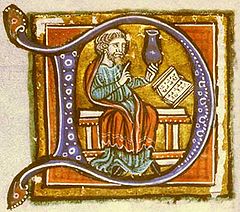Hunayn bin Ishaq
| Hunayn ibn Ishaq | |
|---|---|

Iluminure from the Hunayn ibn-Ishaq al-'Ibadi manuscript of the Isagoge
|
|
| Born | 809 AD Al-Hira |
| Died | 873 AD |
| Residence | Caliphate |
| Academic work | |
| Era | Islamic Golden Age |
| Main interests | Translation, Ophthalmology, Philosophy, Religion, Arabic grammar |
| Notable works | Book of the Ten Treatises of the Eye |
| Influenced | Ishaq ibn Hunayn |
Hunayn ibn Ishaq al-Ibadi (also Hunain or Hunein) (Syriac: ܚܢܝܢ ܒܪ ܐܝܣܚܩ, Arabic: أبو زيد حنين بن إسحاق العبادي; ’Abū Zayd Ḥunayn ibn ’Isḥāq al-‘Ibādī; Latin: Iohannitius) (809 – 873) was a famous and influential Nestorian (Christian) scholar, physician, and a scientist from Mesopotamia, what is now Iraq. He and his students transmitted their Syriac and Arabic translations of many classical Greek texts throughout the Islāmic world, during the apex of the Islamic Abbasid Caliphate. Ḥunayn ibn Isḥaq was the most productive translator of Greek medical and scientific treatises in his day. He studied Greek and became known among the Arabs as the "Sheikh of the translators". He mastered four languages: Arabic, Syriac, Greek and Persian. His translations did not require corrections; Hunayn’s method was widely followed by later translators. He was originally from southern Iraq but he spent his working life in Baghdad, the center of the great ninth-century Greek-into-Arabic/Syriac translation movement. His fame went far beyond his own community.
In the Abbasid era, a new interest in extending the study of Greek science had arisen. At that time, there was a vast amount of untranslated ancient Greek literature pertaining to philosophy, mathematics, natural science, and medicine. This valuable information was only accessible to a very small minority of Middle Eastern scholars who knew the Greek language; the need for an organized translation movement was urgent. In time, Hunayn ibn Ishaq became arguably the chief translator of the era, and laid the foundations of Islamic medicine. In his lifetime, ibn Ishaq translated 116 works, including Plato’s Timaeus, Aristotle’s Metaphysics, and the Old Testament, into Syriac and Arabic. Ibn Ishaq also produced 36 of his own books, 21 of which covered the field of medicine. His son Ishaq, and his nephew Hubaysh, worked together with him at times to help translate. Hunayn ibn Ishaq is known for his translations, his method of translation, and his contributions to medicine. He has also been suggested by François Viré to be the true identity of the Arabic falconer Moamyn, author of De Scientia Venandi per Aves.
...
Wikipedia
